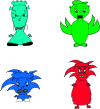Spoken Word Learning Differences Among Children With Dyslexia, Concomitant Dyslexia and Developmental Language Disorder, and Typical Development
- PMID: 31600465
- PMCID: PMC7210431
- DOI: 10.1044/2019_LSHSS-VOIA-18-0138
Spoken Word Learning Differences Among Children With Dyslexia, Concomitant Dyslexia and Developmental Language Disorder, and Typical Development
Abstract
Purpose The purpose of our study was to test the hypotheses (a) that children with dyslexia have spoken word learning deficits primarily related to phonology and (b) that children with dyslexia and concomitant developmental language disorder (DLD) have word learning deficits related to both phonology and semantic processing when compared to peers with typical development (TD). Method Second-graders with dyslexia (n = 82), concomitant dyslexia and DLD (dyslexia + DLD; n = 40), and TD (n = 167) learned names and semantic features for cartoon monsters in 5 carefully controlled word learning tasks that varied phonological and semantic demands. The computer-based tasks were played in 6 different word learning games. We analyzed results using Bayesian statistics. Results In general, the dyslexia + DLD group showed lower accuracy on tasks compared to the dyslexia and TD groups. As predicted, word learning tasks that taxed phonology revealed deficits in the dyslexia group, although there were some exceptions related to visual complexity. Word learning deficits in the dyslexia + DLD group were present in tasks that taxed phonology, semantic processing, or both. Conclusions The dyslexia + DLD group demonstrated word learning deficits across the range of word learning tasks that tapped phonology and semantic processing, whereas the dyslexia group primarily struggled with the phonological aspects of word learning. Supplemental Material https://doi.org/10.23641/asha.9807929.
Figures









References
-
- Alt M., Hogan T., Green S., Gray S., Cabbage K., & Cowan N. (2017). Word learning deficits in children with dyslexia. Journal of Speech, Language, and Hearing Research, 60, 1012–1028. https://doi.org/10.1044/2016_JSHLR-L-16-0036 - PMC - PubMed
Publication types
MeSH terms
Grants and funding
LinkOut - more resources
Full Text Sources
Medical
Research Materials
Miscellaneous

